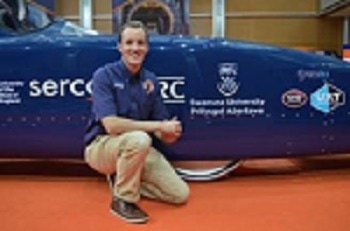May 5 2016
Internationally renowned aerospace engineering expert and Swansea University senior lecturer Dr Ben Evans will be sharing his expertise on the Bloodhound project at an international conference in Japan next week.
 Dr Ben Evans with the BLOODHOUND SSC car
Dr Ben Evans with the BLOODHOUND SSC car
Dr Evans will be giving a Plenary Lecture entitled “The use of CFD in the design of a 1,000mph car: Bloodhound SSC, an engineering adventure” to a worldwide audience of experts at the International Parallel CFD Conference in Kobe, Japan on Wednesday 11 May.
Engineering at Swansea University has an extensive track record of industrial collaboration and has significantly contributed to a number of prestigious projects. From the aerodynamic design of the THRUST Supersonic Car, which currently holds the world land-speed record, to the latest collaboration, aerodynamically designing the BLOODHOUND Supersonic Car.
Dr Evans sits on the design team for the BLOODHOUND SSC Land Speed Record project. His Computational Fluid Dynamics (CFD) research for BLOODHOUND SSC is taking place at the Swansea University Zienkiewicz Centre for Computational Engineering. These computational models have already influenced significant design aspects of BLOODHOUND including the front wheel configuration, the shape of the nose, the jet engine intake shaping, rear wheel fairings and wing shape and size. The CFD modelling continues to be one of the prominent tools used to develop the surface geometry of BLOODHOUND.
My lecture will focus on the scientific and engineering challenges faced by the Bloodhound team, which includes researchers from Swansea University, in their quest to take a manned vehicle to 1000mph by 2017.
Dr Evans
“ The Computatioal Fluid Dynamics research team at The College of Engineering, Swansea University has been working on the challenges we face not least of which being how the car will stay attached to the ground at these speeds and we have been developing computational models of the aerodynamic flows that BLOODHOUND will experience to help shape the vehicle design and predicting the overall aerodynamic behaviour of the vehicle.
“ High Performance Computing was used as an integral component of the design and optimization cycles for the vehicle. In order to achieve the final design predicted lift and drag responses over 14 full vehicle design iterations were carried out.
The Bloodhound SSC is being built and the UK runway trials are planned for later in 2016 with the first (800mph) record attempt projected to take place the following year. Exciting times.
Dr Evans